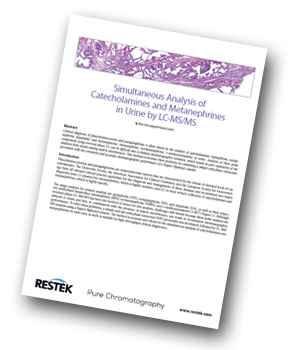Restek has produced an application note introducing a simple solid-phase extraction procedure for the simultaneous analysis of catecholamines and metanephrines in urine that is suitable for high-throughput clinical diagnostics.
Abstract
Clinical diagnosis of pheochromocytoma and paraganglioma is often based on the analysis of catecholamines (epinephrine, norepinephrine, dopamine) and metanephrines (metanephrine, normetanephrine, 3-methoxytyramine) in urine. Analysis of these polar compounds using reversed-phase LC can be difficult due to limited chromatographic retention, which results in poor separation of the analytes from closely eluting matrix interferences. This application note describes a method that overcomes these problems by combining a simple solid-phase extraction procedure with the consistent and accurate chromatographic performance of a Raptor Biphenyl column.
 Introduction
Introduction
Pheochromocytomas and paragangliomas are neuroendocrine tumors that are characterized by the release of elevated levels of catecholamines. The Endocrine Society, the American Association for Clinical Chemistry, and the European Society for Endocrinology have all released clinical practice guidelines for the diagnosis and management of these diseases and recommend two major diagnostic tests: (1) plasma free metanephrines, which is highly sensitive, and (2) 24-hour urinary collection of catecholamines and metanephrines, which is highly specific.
Experimental
Solid-Phase Extraction
A 200 μL aliquot of urine sample was mixed with 10 μL of internal standard solution (1 μg/mL in methanol) and 600 μL of 250 mM ammonium acetate solution. The mixture was loaded onto the EVOLUTE EXPRESS WCX 96-well plate (30 mg) and washed with
1 mL water and 1 mL methanol:acetonitrile (60:40). The elution was performed with 200 μL of water:methanol (95:5) solution containing 5% formic acid and then 2 μL was injected for analysis.
Urine Analysis
To confirm that the validated method could accurately measure the urinary catecholamines and metabolites, two levels of urine samples (Bio-Rad Lyphochek quantitative urine controls) were analysed with the established SPE and chromatographic methods. The normal urine was fortified with 10 ng/mL of epinephrine, norepinephrine, 3-methoxytyramine, and 100 ng/mL of dopamine, metanephrine, and normetanephrine. The abnormal urine was fortified with 50 ng/mL of epinephrine and norepinephrine and 200 ng/mL of dopamine, metanephrine, normetanephrine, 3-methoxytyramine. Accuracy was determined using the measured concentration difference between the blank and fortified urine.
Results and Discussion
Chromatographic Performance
The analysis of normal human urine (Bio-Rad Lyphochek quantitative urine control, level 1) demonstrates that a fast 5-minute chromatographic analysis is achieved with direct injection of the elution solution that was obtained from the simple SPE procedure. The Raptor Biphenyl column provided adequate retention such that all target analytes could be quantified with no observed influence from matrix interferences.
Urine Analysis
From three sets of analyses of blank and fortified urine samples (BioRad Lyphochek quantitative urine control, level 1 and level 2), the results showed that the recoveries of all fortified samples were within 90–105% of their nominal values. This demonstrated that the validated method is suitable for the analysis of catecholamines and metanephrines in urine from human patients at clinically relevant levels.
Conclusion
As demonstrated here, the Raptor Biphenyl column provides good retention and accurate results for the simultaneous analysis of catecholamines and metanephrines in urine. With a fast, simple sample preparation procedure and just five minutes of chromatographic analysis time, the established method is recommended for high-throughput labs supporting the clinical diagnosis of pheochromocytoma and paraganglioma.




